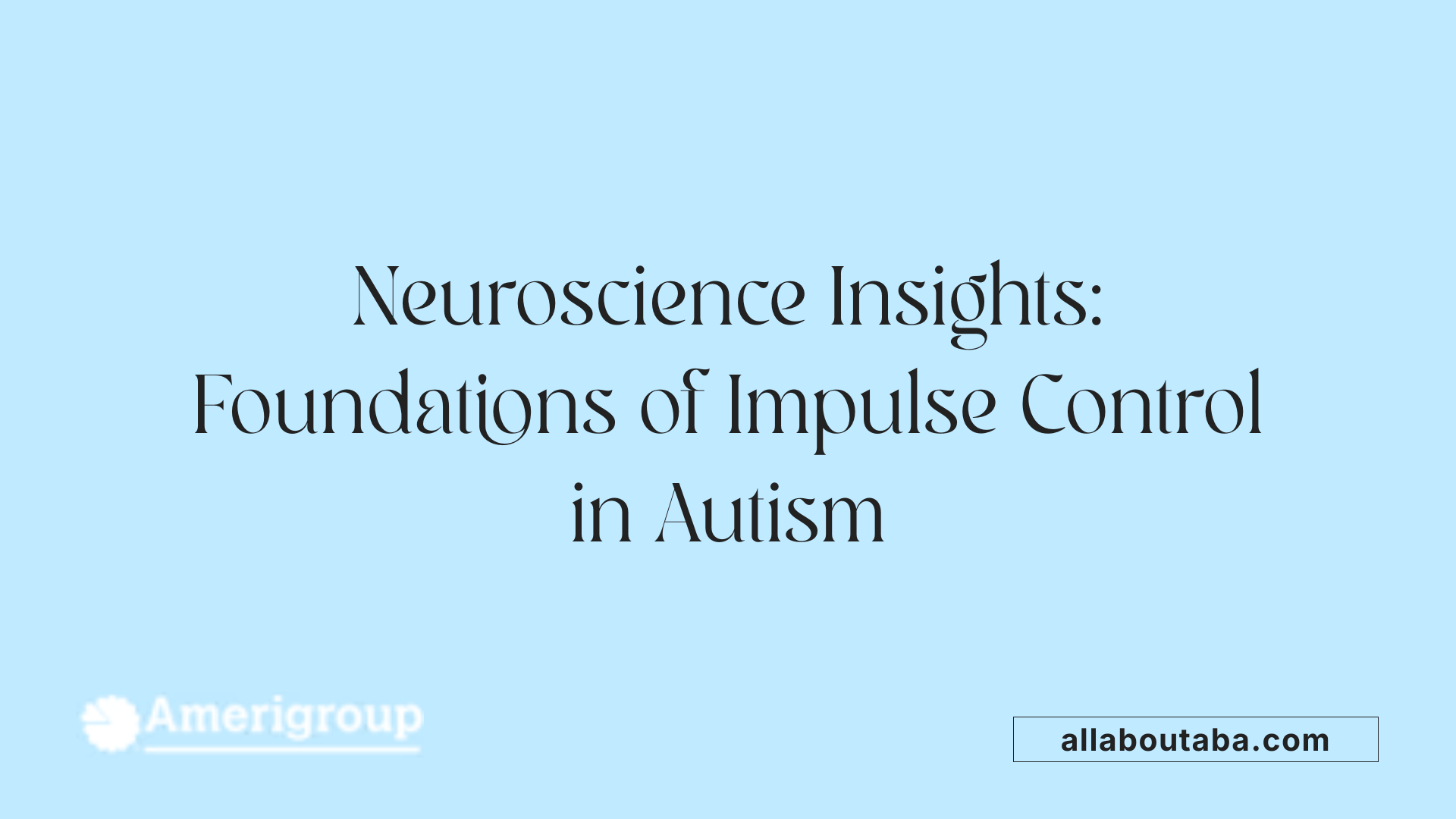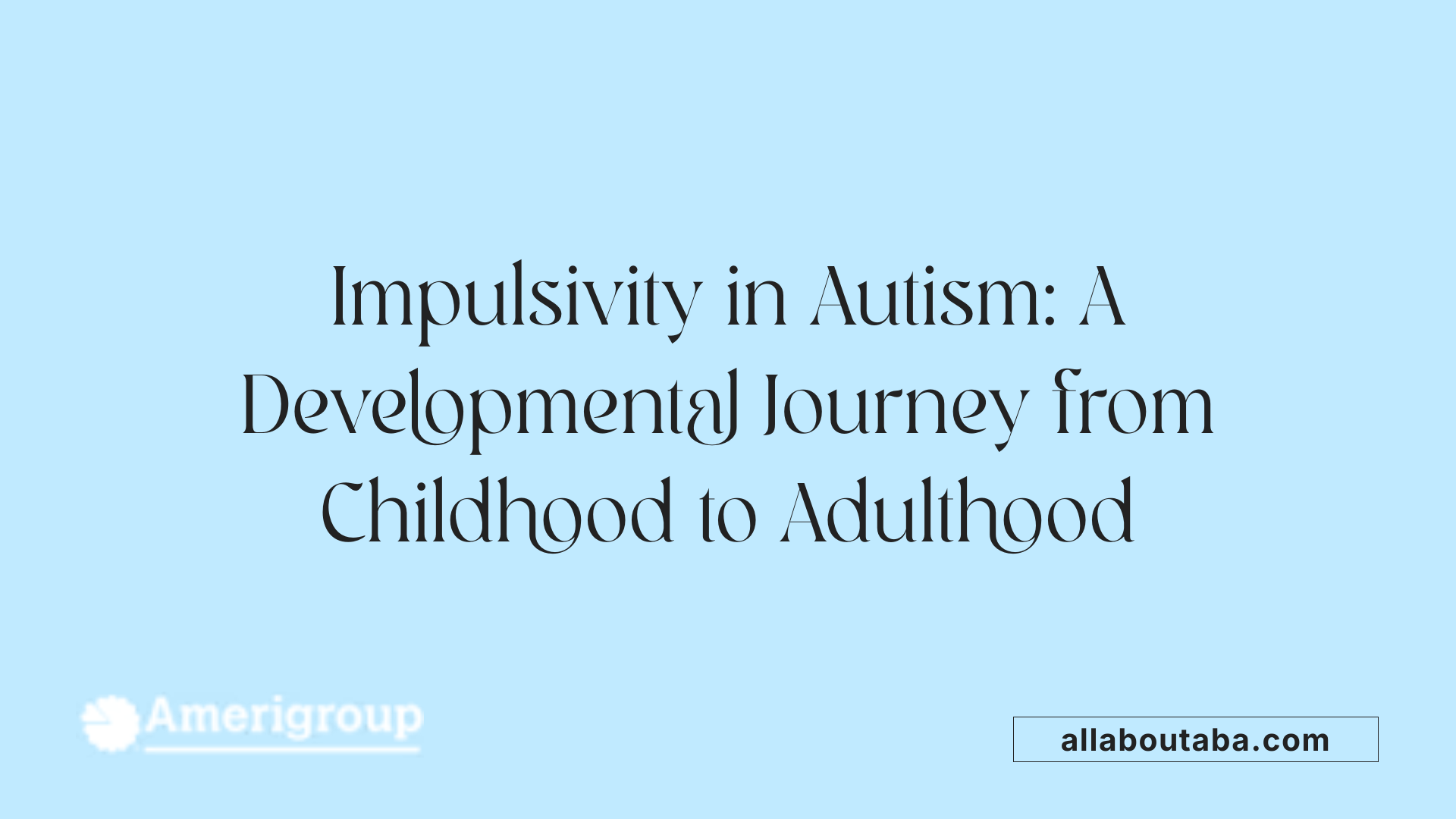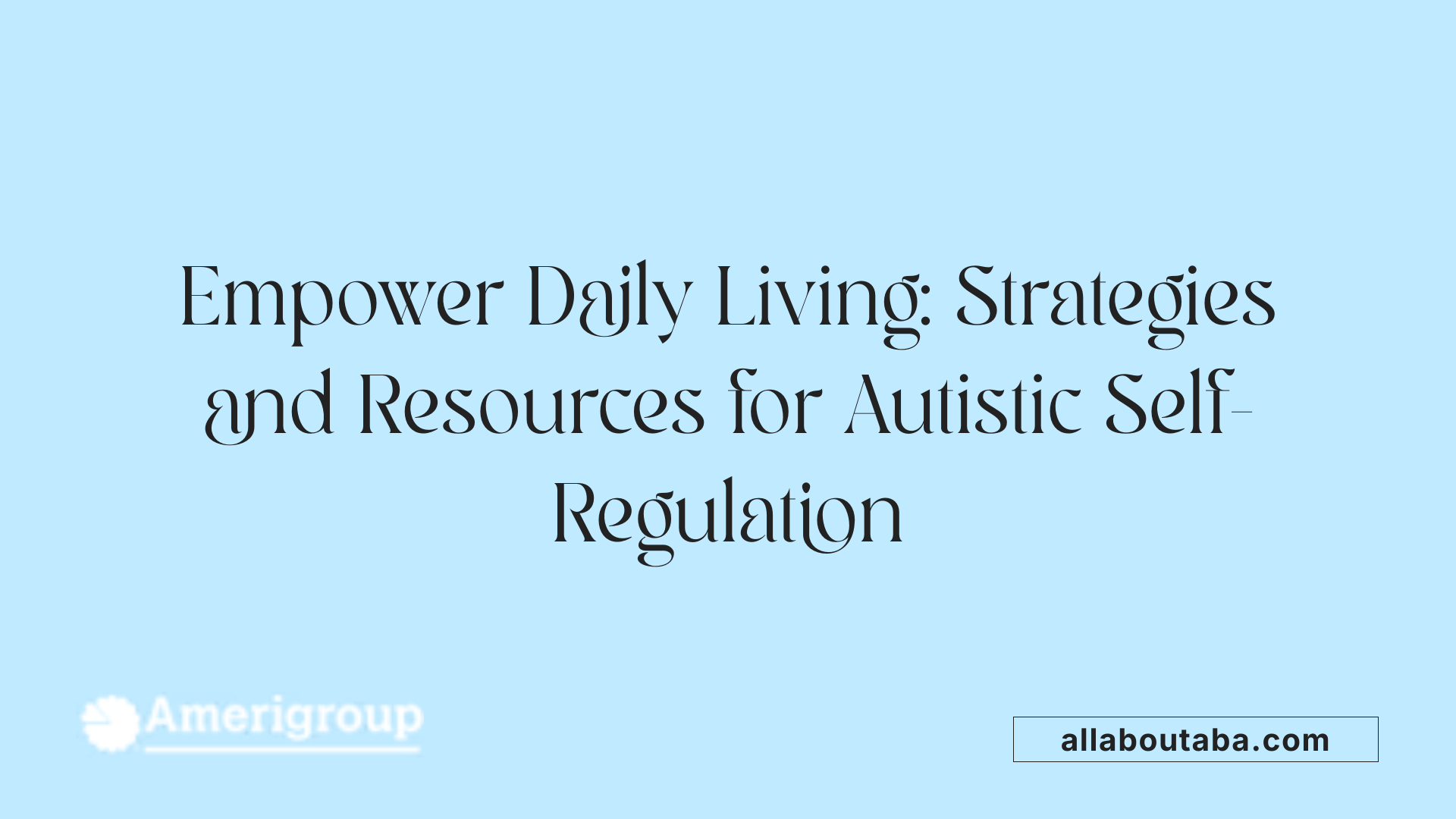Exploring the Complex Relationship Between Autism and Impulse Control
Impulsivity is a common challenge faced by many individuals with autism spectrum disorder (ASD). Recognizing how impulse control issues manifest and understanding the neural and behavioral mechanisms involved are critical steps toward supporting affected individuals. This article delves into the underlying cognitive deficits, assessment techniques, developmental aspects, therapeutic strategies, and resources available to address impulse control in autism, offering a comprehensive overview for caregivers, educators, and clinicians.
Neural and Cognitive Foundations of Impulse Control in Autism

How can impulse control issues be recognized in individuals with autism?
Impulsive control difficulties in individuals with autism are often observable through specific behaviors that indicate challenges with self-regulation. These include acting impulsively without considering consequences, difficulties in delaying gratification, and engaging in sudden, intense emotional reactions. Autistic children and adults may display behaviors such as grabbing objects, interrupting conversations, switching activities rapidly, or exhibiting tantrums or emotional outbursts.
Other signs include difficulty waiting for turns, touching objects impulsively, seeking sensory input excessively, and acting unaware of potential danger. These behaviors can often be linked to underlying deficits in executive functions, especially response inhibition and behavioral regulation.
By observing these signs across different environments—home, school, or social settings—caregivers and professionals can better identify impulse control issues. Awareness of these behaviors, coupled with understanding their roots in executive dysfunction, allows for targeted support and intervention plans.
Developmental Trajectory and Behavioral Manifestations of Impulsivity in Autism

How does impulse control differ between children and adults with autism?
Impulse control in individuals with autism varies significantly across different ages due to neurodevelopmental factors. In children, impulsivity is often quite visible, manifesting through behaviors such as acting without thinking, difficulties waiting for turns, rapid emotional reactions, and engaging in risky activities. These behaviors stem largely from immature or underdeveloped frontal lobe functions, particularly in areas responsible for executive control like response inhibition and interference control.
As children with autism grow, their impulse regulation usually improves; this is linked to the natural maturation of the prefrontal cortex, which enhances their ability to plan, organize, and control impulses. However, some challenges persist into adulthood, often presenting as subtler difficulties. Adults with autism may struggle with social decision-making, risk assessment, or controlling inappropriate responses in complex situations. They might show behaviors like impulsive risk-taking, difficulty in delaying gratification, or responding in ways that are socially unexpected.
Interventions such as behavioral therapies, including Applied Behavior Analysis (ABA), and supports tailored to individual needs can assist in managing impulse control issues across all ages. Nevertheless, ongoing neurological differences influence the severity and nature of impulsivity, requiring continuous support and adaptation. Overall, understanding this developmental trajectory helps in creating effective strategies to support individuals with autism, fostering better social functioning and emotional regulation.
Behavioral Challenges and Emotional Regulation in Autism

How can impulse control issues be recognized in individuals with autism?
Impulsive control issues in individuals with autism often manifest through behaviors like acting without thinking, having difficulty delaying gratification, and experiencing rapid mood swings. Common signs include struggling to wait their turn, switching activities suddenly and without warning, and seeking sensory input excessively or impulsively grabbing objects.
Children with these challenges may exhibit behaviors such as pouting, tantrums, or pushing boundaries, which are signs of difficulty in self-regulation. They might not be aware of dangers in their environment, leading to unsafe actions.
These behaviors are usually tied to deficits in executive functioning, especially in areas like response inhibition and behavioral regulation. Recognizing these signs across different settings—home, school, and social environments—and understanding the context in which they occur can help caregivers and teachers identify impulse control issues early. Observation of repeated patterns of impulsiveness, like pesteriness or impulsive aggression, often signals underlying executive dysfunction.
The Role of Executive Dysfunction in Impulsive Behaviors

What is the relationship between executive dysfunction and impulse control challenges in autism?
In autism, difficulties with executive functions—such as planning, flexibility, working memory, and cognitive inhibition—are common. These skills, often regulated by the prefrontal cortex of the brain, are essential for controlling impulses, managing emotions, and organizing behaviors.
When executive functioning is impaired, children and adults with autism may struggle with self-control, leading to impulsive behaviors. For example, they might impulsively touch objects, interrupt conversations, or act out emotionally without prior thought. This lack of behavioral regulation can manifest as outbursts, wandering, or quick mood swings.
Difficulties in emotional regulation and communication further contribute to impulse control challenges. Because they find it hard to process or anticipate the consequences of their actions, they may indulge immediate urges more readily.
Although executive dysfunction is not a core feature of autism, it frequently overlaps with the condition, significantly impacting daily functioning and social interactions. Addressing these deficits is a critical part of managing impulses effectively. Therapeutic interventions like applied behavior analysis (ABA) focus on improving executive skills, helping individuals develop better self-control and adaptive behaviors.
Are there specific resources or treatments available for managing impulse control issues in autism?
Yes, various resources and treatment approaches are designed to support individuals in overcoming impulse control challenges. Occupational therapy (OT), speech therapy (ST), applied behavior analysis (ABA), and physical therapy (PT) are commonly used to enhance self-regulation and executive functioning.
These therapies employ a range of techniques:
- Sensory integration exercises (e.g., sensory bins, tactile activities)
- Social skills training through role-playing and social stories
- Reinforcement programs, like token economies, to encourage desired behaviors
- Structured routines and visual schedules to foster predictability
- Motor activities such as obstacle courses and balance exercises to improve body awareness
Furthermore, support tools tailored to individual needs can be very effective:
| Resource/Intervention | Description | How It Supports Impulse Control |
|---|---|---|
| Visual Schedules | Visual aids that outline daily routines | Reduces anxiety and impulsive reactions by increasing predictability |
| Reinforcement Strategies | Rewards for self-control | Encourages positive behavior and patience |
| Role-Playing Activities | Practice social scenarios | Improves communication, emotional regulation, and impulse management |
| Sensory Integration Therapy | Activities designed to regulate sensory responses | Helps reduce sensory overload that may trigger impulsive acts |
Understanding individual triggers and applying tailored strategies are essential. Professionals experienced in autism can develop personalized plans that incorporate emotional regulation techniques, coping strategies, and environmental modifications to effectively manage impulsive behaviors.
In summary, managing impulse control in autism involves a combination of therapy, environmental supports, and skill-building resources. Collaboration with healthcare providers ensures that interventions are adapted to each person's unique profile, promoting better daily functioning and social participation.
Therapies and Techniques to Foster Self-Regulation in Autism
What types of therapies support impulse control in children with autism?
Addressing impulse control challenges in autistic children involves a range of therapeutic strategies tailored to improve self-regulation, executive functioning, and social skills. Several evidence-based approaches work together to help children develop better control over their behaviors and reactions.
Occupational Therapy with sensory integration
Occupational therapy (OT) plays a pivotal role in enhancing self-regulation through sensory integration activities. These activities help children process sensory stimuli more effectively, leading to calmer behavior and improved impulse control. Common OT techniques include sensory bins, where children explore textures and sensations, and body awareness exercises like balance beams or obstacle courses. OT therapists also incorporate activities such as sorting games, handcrafts, and role-playing to promote focus and calming responses.
Speech Therapy focusing on social skills
Speech therapy (ST) emphasizes communication development and social understanding. Improved communication reduces frustration and impulsive behaviors. Techniques like freeze games teach children self-control by pausing before acting, while sequencing stories and turn-taking games offer practice in patience and social reciprocity. These activities help children interpret social cues and respond more thoughtfully, fostering better impulse management.
ABA strategies for behavior modification
Applied Behavior Analysis (ABA) employs structured interventions to modify impulsive behaviors through the ABC approach—analyzing antecedents, behaviors, and consequences. Therapists use reinforcement strategies to encourage self-control, such as giving preferred items or praise when children delay gratification or self-regulate. Activities like balancing tasks and waiting exercises are integrated into play routines, teaching children to pause and consider their actions before responding.
Physical therapy for motor control and body awareness
Physical therapy (PT) enhances impulse control by developing motor skills and body awareness. Engaging children in controlled physical activities—relay races, obstacle navigation, jumping exercises—improve their ability to regulate impulses related to movement. These activities also enhance proprioception, helping children recognize their body position and control impulsive movement tendencies.
Incorporating visual supports, routines, and structured activities
Creating consistent routines and visual supports significantly supports impulse regulation. Visual schedules outline daily tasks, reducing anxiety and uncertainty that often trigger impulsivity. Breaking tasks into small, manageable steps helps children focus and succeed, lessening impulsive jumpings to new or unrelated activities.
Structured activities like games and crafts, which require patience and turn-taking, are essential for practicing self-restraint. Reinforcement, such as tokens or praise, sustains motivation and encourages children to apply these skills across various settings.
Resources and treatment options available
To effectively manage impulse control issues, families and caregivers can turn to specialized resources and interventions. These include targeted therapies such as occupational, speech, and physical therapies, alongside ABA programs tailored to individual needs. Support tools like visual schedules, token reinforcement systems, and social stories reinforce self-regulation strategies.
Functional behavior assessments identify specific triggers, guiding personalized intervention plans. Emotional regulation techniques, coping strategies, and parent training further empower families to support their children’s development.
In summary, a combination of sensory integration, social skills training, structured routines, and physical exercises forms a comprehensive approach to fostering better impulse control in children with autism. Engaging professionals in these fields ensures that interventions are customized and effective.
Supporting Autistic Individuals in Daily Life Through Strategies and Resources

Building routines and visual supports
Establishing consistent routines and visual supports plays a crucial role in helping autistic individuals develop better impulse control and overall self-regulation. Visual schedules, for example, break down daily tasks into manageable steps, reducing uncertainty and emotional distress. These tools enable children to anticipate upcoming activities, giving them a sense of control and predictability, which can decrease impulsive reactions driven by surprise or confusion.
Visual supports also include social stories, picture cards, and cue charts. These provide clear, visual cues about expected behaviors and social norms, helping children understand what is appropriate in different situations. By reinforcing routines and expectations visually, children can learn to self-regulate behaviors like waiting their turn or resisting impulse actions.
Sensory regulation techniques
Many children with autism experience sensory processing differences that influence their impulse control. Sensory regulation techniques such as using sensory bins, weighted blankets, fidget tools, or calming sensory activities can help mitigate over- or under-stimulation, which often triggers impulsive behaviors.
Engaging in sensory input tailored to an individual’s needs helps promote calmness and focus. For example, controlled sensory activities like squeezing stress balls or engaging in deep pressure input can soothe hyper-aroused sensory systems, preventing escalation into impulsive or aggressive behaviors.
Behavioral and social skills training
Behavioral interventions like Applied Behavior Analysis (ABA) target specific impulsive behaviors through structured activities and reinforcement strategies. ABA employs the ABC approach, manipulating antecedents and consequences to modify behaviors.
Social skills training helps children learn appropriate ways to interact, share, wait, and communicate. Activities such as role-playing, turn-taking games, and structured play teach children how to regulate their impulses during social interactions, reducing behaviors like impulsive grabbing or interrupting.
Therapies: Occupational, speech, ABA, and physical
Various therapies support impulse control development in autistic children:
| Therapy Type | Focus | Activities & Techniques | How It Helps |
|---|---|---|---|
| Occupational Therapy (OT) | Sensory integration, executive functioning | Sensory bins, sorting, role-playing, craft activities | Improves sensory regulation, attention, and impulse control |
| Speech Therapy (ST) | Communication & social skills | Freeze games, story sequencing, turn-taking exercises | Enhances understanding of social cues, self-regulation |
| Applied Behavior Analysis (ABA) | Behavior modification | Structured tasks, reinforcement, self-regulation training | Reduces impulsive behaviors, increases self-control |
| Physical Therapy (PT) | Motor skills, body awareness | Obstacle courses, balance exercises, obstacle navigation | Supports overall emotional regulation and impulse management |
These therapies, tailored to individual needs, work synergistically to improve impulse control and social functioning.
Can self-regulation techniques help autistic individuals manage impulsive behaviors?
Yes, self-regulation techniques can help autistic individuals manage impulsive behaviors effectively. These techniques encompass emotional regulation strategies such as identifying and understanding emotions, using visual supports, social stories, and calming strategies like deep breathing or sensory input. Supporting self-soothing behaviors without misunderstanding them, creating routines, and practicing coping skills in real-life settings are also beneficial. Moreover, interventions like mindfulness, social stories, and visual tools help improve emotional awareness and impulse control. Overall, tailored self-regulation strategies can significantly enhance an autistic individual's ability to manage impulsivity and improve their social and emotional well-being.
Navigating Impulse Control Challenges in Autism Spectrum Disorder
Managing impulse control in autism requires a multifaceted approach that considers neurological, behavioral, and environmental factors. Understanding the neural mechanisms involved, such as atypical activity in the fronto-parietal network and deficits in response inhibition, provides insight into why impulsivity occurs. Recognizing signs early, especially in children, allows for timely intervention through tailored therapies including ABA, OT, speech therapy, and physical exercises. Supporting self-regulation, emotional awareness, and executive functioning can significantly improve behavioral outcomes. Resources such as visual supports, structured routines, and professional guidance enable caregivers and individuals to develop effective coping strategies. Though challenges may persist, a committed, informed approach fosters better impulse management, enhancing social integration, safety, and overall quality of life for those on the autism spectrum.
References
- Autism, impulsivity and inhibition a review of the literature
- Impulse Control Disorder and Autism: All You Need to Know
- 40 Activities to improve impulse control in Autism
- Examining The Relationship Between Autism & Impulse Control!
- Autism and Impulsive Aggression: All You Need to Know
- Treatment of Inattention, Overactivity, and Impulsiveness in Autism ...
- [PDF] Emotional Regulation Strategies
- Expert Q&A: Understanding autism emotional regulation







